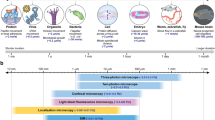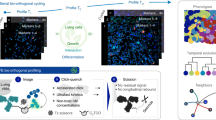Abstract
Live cell microscopy has become a common technique for exploring dynamic biological processes. When combined with fluorescent markers of cellular structures of interest, or fluorescent reporters of a biological activity of interest, live cell microscopy enables precise temporally and spatially resolved quantitation of the biological processes under investigation. However, because living cells are not normally exposed to light, live cell fluorescence imaging is significantly hindered by the effects of photodamage, which encompasses photobleaching of fluorophores and phototoxicity of the cells under observation. In this chapter, we outline several methods for optimizing and maintaining long-term imaging of live cells while simultaneously minimizing photodamage. This protocol demonstrates the intracellular trafficking of early and late endosomes following phagocytosis using both two and three dimensional imaging, but this protocol can easily be modified to image any biological process of interest in nearly any cell type.
Access this chapter
Tax calculation will be finalised at checkout
Purchases are for personal use only
Similar content being viewed by others
References
Cole R (2014) Live-cell imaging. Cell Adh Migr 8:452–459
Magidson V, Khodjakov A (2013) Circumventing photodamage in live-cell microscopy. Methods Cell Biol 114:545–560
Icha J, Weber M, Waters JC et al (2017) Phototoxicity in live fluorescence microscopy, and how to avoid it. Bioessays 39:1700003
Stennett EMS, Ciuba MA, Levitus M (2014) Photophysical processes in single molecule organic fluorescent probes. Chem Soc Rev 43:1057–1075
Laloi C, Havaux M (2015) Key players of singlet oxygen-induced cell death in plants. Front Plant Sci 6:39
Thorpe GW, Fong CS, Alic N et al (2004) Cells have distinct mechanisms to maintain protection against different reactive oxygen species: oxidative-stress-response genes. Proc Natl Acad Sci U S A 101:6564–6569
Schindelin J, Arganda-Carreras I, Frise E et al (2012) Fiji: an open-source platform for biological-image analysis. Nat Methods 9:676–682
Flannagan RS, Jaumouillé V, Grinstein S (2011) The cell biology of phagocytosis. Annu Rev Pathol 7:61–98
Hennies CM, Lehn MA, Janssen EM (2015) Quantitating MHC class II trafficking in primary dendritic cells using imaging flow cytometry. J Immunol Methods 423:18–28
Bohdanowicz M, Grinstein S (2010) Vesicular traffic: a Rab SANDwich. Curr Biol 20:R311–R314
Hwang J-R, Byeon Y, Kim D et al (2020) Recent insights of T cell receptor-mediated signaling pathways for T cell activation and development. Exp Mol Med 52:750–761
Kagan JC, Iwasaki A (2012) Phagosome as the organelle linking innate and adaptive immunity. Traffic 13:1053–1061
Hampton MB, Vissers MC, Winterbourn CC (1994) A single assay for measuring the rates of phagocytosis and bacterial killing by neutrophils. J Leukoc Biol 55:147–152
Paul D, Achouri S, Yoon Y-Z et al (2013) Phagocytosis dynamics depends on target shape. Biophys J 105:1143–1150
Vieira OV, Bucci C, Harrison RE et al (2003) Modulation of Rab5 and Rab7 recruitment to phagosomes by phosphatidylinositol 3-kinase. Mol Cell Biol 23:2501–2514
Yin C, Kim Y, Argintaru D et al (2016) Rab17 mediates differential antigen sorting following efferocytosis and phagocytosis. Cell Death Dis 7:e2529
Wong C-O, Gregory S, Hu H et al (2017) Lysosomal degradation is required for sustained phagocytosis of bacteria by macrophages. Cell Host Microbe 21:719–730.e6
Kleijmeer MJ, Ossevoort MA, van Veen CJ et al (1995) MHC class II compartments and the kinetics of antigen presentation in activated mouse spleen dendritic cells. J Immunol 154:5715–5724
Banaz N, Mäkelä J, Uphoff S (2019) Choosing the right label for single-molecule tracking in live bacteria: side-by-side comparison of photoactivatable fluorescent protein and halo tag dyes. J Phys D Appl Phys 52:064002
Lambert TJ (2019) FPbase: a community-editable fluorescent protein database. Nat Methods 16:277–278
Perskvist N, Roberg K, Kulyté A et al (2002) Rab5a GTPase regulates fusion between pathogen-containing phagosomes and cytoplasmic organelles in human neutrophils. J Cell Sci 115:1321–1330
Rupper A, Grove B, Cardelli J (2001) Rab7 regulates phagosome maturation in. Dictyostelium 114:2449–2460
Bogdanov AM, Kudryavtseva EI, Lukyanov KA (2012) Anti-fading media for live cell GFP imaging. PLoS One 7:e53004
Comes MC, Casti P, Mencattini A et al (2019) The influence of spatial and temporal resolutions on the analysis of cell-cell interaction: a systematic study for time-lapse microscopy applications. Sci Rep 9:6789
Kreft M, Stenovec M, Zorec R (2005) Focus-drift correction in time-lapse confocal imaging. Ann N Y Acad Sci 1048:321–330
Zhao Q, Young IT, de Jong JGS (2011) Photon budget analysis for fluorescence lifetime imaging microscopy. J Biomed Opt 16:086007
Mubaid F, Brown CM (2017) Less is more: longer exposure times with low light intensity is less photo-toxic. Microsc Today 25:26–35
Wu P-H, Nelson N, Tseng Y (2010) A general method for improving spatial resolution by optimization of electron multiplication in CCD imaging. Opt Express 18:5199–5212
Jin X, Hirakawa K (2012) Analysis and processing of pixel binning for color image sensor. EURASIP J Adv Signal Process 2012:125
Hu X, Jalal S, Sheetz M et al (2020) Micro-stepping extended focus reduces photobleaching and preserves structured illumination super-resolution features. J Cell Sci 133:jcs240796
Shihavuddin A, Basu S, Rexhepaj E et al (2017) Smooth 2D manifold extraction from 3D image stack. Nat Commun 8:15554
Frigault MM, Lacoste J, Swift JL et al (2009) Live-cell microscopy - tips and tools. J Cell Sci 122:753–767
Carlton PM, Boulanger J, Kervrann C et al (2010) Fast live simultaneous multiwavelength four-dimensional optical microscopy. Proc Natl Acad Sci U S A 107:16016–16022
Acknowledgments
This work was funded by a Canadian Institutes of Health Research Project Grant (PJT-162203) to BH.
Author information
Authors and Affiliations
Corresponding author
Editor information
Editors and Affiliations
Rights and permissions
Copyright information
© 2022 The Author(s), under exclusive license to Springer Science+Business Media, LLC, part of Springer Nature
About this protocol
Cite this protocol
Lac, A., Le Lam, A., Heit, B. (2022). Optimizing Long-Term Live Cell Imaging. In: Heit, B. (eds) Fluorescent Microscopy. Methods in Molecular Biology, vol 2440. Humana, New York, NY. https://doi.org/10.1007/978-1-0716-2051-9_3
Download citation
DOI: https://doi.org/10.1007/978-1-0716-2051-9_3
Published:
Publisher Name: Humana, New York, NY
Print ISBN: 978-1-0716-2050-2
Online ISBN: 978-1-0716-2051-9
eBook Packages: Springer Protocols




